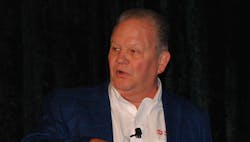The digital future of decarbonized energy
As critical as the effort is, many of the commonly pursued steps to decarbonization—think electrification, the use of renewable energy, intensifying energy-efficiency measures—pose unique challenges. Likewise, the largest global contributors to carbon emissions are varied—they come from different verticals and add to the challenge in their own unique ways.
The speakers at this week’s Automation Fair industry forum titled “The Future of Energy with Decarbonization and Emerging Energies” addressed their respective industries’ contributions to the problem and the unique approaches each is taking to mitigate the severity.
Paul McRoberts, regional industry mining, metals & cement manager at Rockwell Automation addressed sustainability programs for mining trucks, which he explained are the world’s largest consumers of diesel. Examples include converting to hydrogen-cell power to lessen the reliance on traditional fuels, adopting waterless mining techniques and using fewer chemical agents in extraction processes. “Rockwell Automation is at play in a lot of these today,” he said, referencing how the digital thread optimizes energy usage and reporting.
Tom Mott, Rockwell Automation industry leader for automotive and tire, detailed programs in place to reduce carbon emissions in the automotive space, spending much of his time talking about the changes being ushered in by electric vehicles. “I can sum up the automotive industry in one word: crazy,” he said, before explaining how electric vehicles are increasingly being coupled with the move toward autonomous vehicles, and how the digital thread, informed by decades of work with traditional auto manufacturing, is unleashing new strategies. This is enabling what Mott called “multi-dimensional smart manufacturing,” which optimizes the entire value stream of car manufacturing and, ultimately, their more energy-efficient use out on the roads.
Ramon Farach, global chemical industry technical consultant at Rockwell Automation, tackled emissions in the chemicals arena, noting that among other, more obvious benefits of working more efficiently, companies maintaining a strong, public commitment to sustainable chemical-processing practices are a great lure to young talent, for whom this is a top issue when selecting an employer.
Finally, Mike Ilgen, Rockwell Automation’s North American industry manager, oil and gas, delivered insights that touched on each of the industries covered by his fellow panelists, since oil and gas powers much of these efforts.
He warmed up the crowd with good news: about 60% of emissions in the oil/gas value chain is caused by leaks—“fugitive emissions” that can be fixed with digital tools and techniques aligned with a smart decarbonization strategy, applicable to most industries. He labels this “The 5 Rs”:
- Reduce: Implement energy-efficiency measures and transition to cleaner fuels such as methane and hydrogen. Prioritize flare minimization and combustion optimization. Minimize leaks.
- Reuse: Convert industrial waste into useful products.
- Recycle: Implement mobile carbon-capture from vehicles.
- Remove: Enhance oil recovery. Implement direct-air capture techniques. Adopt more nature-based solutions.
- Renew: Renew biofuel, wind, solar, hydro and geo-thermal sources.
The editors of Control, Control Design and Smart Industry are reporting live from Automation Fair. When the event comes to a close, the editors will compile a report of the best, most important coverage from the event. Register now to pre-order the report and be among the first to receive it in your inbox. Pre-order your copy now.
“Our goals are ambitious and will be difficult to get to,” Ilgen admitted, but there are front-runners whose experiences provide optimism and a roadmap. He cited Shell’s firm commitment to decarbonization with digital tools and techniques as an example of a massive, global enterprise responding to massive, global demands.
Ilgen cited enhanced emission-monitoring with the use of drones and smart sensors as an example of a new, digitally enabled approach to old practices. He referenced enhanced recovery efforts when leaks do occur, made quicker by remote monitoring of assets. And he shared an anecdote of a dairy facility with some 650,000 cows that is using the manure generated by that livestock as a viable energy source. This dairy owner relies on a turnkey solution from Rockwell Automation to find a valuable decarbonization solution in the unlikeliest of places.
About the Author
Chris McNamara
Smart Industry

Leaders relevant to this article:
